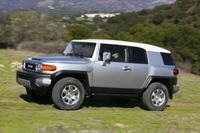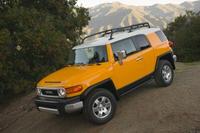2007 Toyota FJ Cruiser Review
A Typical Toyota
By Thom Cannell
Detroit Bureau
The word “typical” appears in most reviews of Toyota products, as in “typical Toyota quality,” “typical Toyota fit and finish,” “typical Toyota attention to detail,” “typical Toyota engineering excellence,” or “typical Toyota engine power and performance.” The all-new 2007 FJ Cruiser, inheritor of the legend of Land Cruiser is thus “A Typical Toyota.” A Toyota that, if priced in the mid-$20 thousand USD as promised, will be a stern competitor to rivals Jeep Wrangler Rubicon, Hummer H3, and Nissan Xterra.
The FJ was introduced in concept at the 2003 Detroit Auto Show and reaffirmed at Chicago, 2005. Its design by Calty Research in California began in 2002 when Toyota recognized a need to reconnect with both younger buyers and off road enthusiasts. The result embraces heritage from old Land Cruisers, modern efficiency, and off road prowess.
Land Cruiser’s origin was in 1951 when a rugged off road vehicle was needed for Japanese police and forestry services. Then named BJ and changed to Land Cruiser in 1954, it has continued in production through a series of model designations, and in 2002 the 120 Prado was introduced to the world—but not the United States. FJ Cruiser is based on this 9th iteration of Toyota trucks and is built in the Hamura plant in Tokyo in conjunction with Hino Motors. Currently FJ Cruiser will be sold only in North America and the Middle East.
Though not a Prado for North America, FJ Cruiser’s frame and front and rear suspensions are adapted from that vehicle. Its welded steel body attaches to a similar boxed steel ladder frame. Front suspension is a similar high-mounted double wishbone with coil-over springs and stabilizer bar. At the rear, a 4-link suspension with coil springs and Panhard rod plus stabilizer bar locate the solid axle. (2WD versions use a tubular steel stabilizer, 4x4 models use solid bars.) The result is 7.87” (199.9 mm) of wheel travel front and 9.1” (231.1 mm) of articulation rear. Though a 4x2 model with a “virtual automatic limited-slip differential” (advanced traction control) is available, it is the 4x4 that interests us.
All FJs are powered by a 4.0-lter 24-valve VVT-I engine producing 239 hp @ 5,200 rpm and 278 lb-ft. of torque at 3,700 rpm. Both a 5-speed automatic with gated shifter and 3.727:1 ratio and 6-speed manual with 3.909:1 ratio are offered; the transfer case is set to 1.000/2.566 low for either transmission. This transfer case is a Torsen locking limited slip differential with 40/60 distribution. Locked, it splits power 50/50. Automatic models use a part-time transfer case. Locking rear differentials are available, as is Toyota’s A-TRAC traction system that applies braking to slipping wheels. It works well enough that many will find locking differentials unnecessary. The result is a payload of 1,325 pounds (601 kg) and trailer tow capacity of 5,000 pounds (2268 kg.)
Our test drive began in Greenville, South Carolina. One of our earliest impressions is that, despite standard P265/70R17 off road tires on 17.5x17 wheels (steel or aluminum alloy),) FJ is quiet, even quieter than a new Camry sedan. On throttle, there is muted engine noise; otherwise it is a very quiet vehicle.
On our first freeway on-ramp we discovered surprising amounts of body roll. Should you be silly enough to do what we do – whip the wheel rapidly left-right-left-right to feel just that, it felt like “flop over and play dead” kind of body roll. This indicates lots of chassis compliance for off roading, but not the best road manners. Of course if you wanted an off road sports car you should get a BMW X3.
We also thought that the variable-ratio hydraulically assisted power steering was curiously compliant. That is, tires responded to input but steering response lagged behind. Even more curious, the steering feels precise and direct. We think the tire sidewalls were responsible. As a result, on the highway, we were required to pay more attention to straight-ahead driving than most competitive vehicles. This is highly influenced by tires, so don’t take this as a fatal flaw in chassis development.
Interiors are interesting and very functional with 8-way adjustable driver and 4-way adjustable passenger seat. Rear seats fold 60/40 and seat cushions are removable for a near-flat load floor. Interiors are covered in easily cleaned fabrics, floors in a rubberized material. The result is handsome enough for a rugged weekend camping, followed by an evening out with family.
Cabin space and surfaces are stylish, with an emphasis on cylindrical forms mixed with functional technology. The dash is almost flat like the original Land Cruiser, whose instrument panel and dashboard was covered Masonite attached to the firewall. FJs’ dash is essentially two cylinders joined by a flat plane. Ends are capped by a constructed aluminum webbing plates that look structural and machined. As a pre-production vehicle many panels were plain, lacking graining and surfacing. The center stack plate will be painted body color.
Instruments are graphically complex and interestingly drawn –white faceplates with large numerals against a dark field- and the layout is utterly simple. The speedometer is central, a smaller tachometer sits on the left, and a cluster of temperature, voltage and fuel gauges fits on the right. Interestingly, a cluster of compass, clock –thermometer, and inclinometers tops the dashboard; we haven’t seen that since Mitsubishi Raider.
The color matched center stack is impressively well laid out, in particular HVAC controls you could operate while wearing Arctic mittens. A lower panel holds other controls for a rear-mounted 400 Watt AC outlet, sub-woofer on/off switch, rear differential lock, A-TRAC Active Traction Control, Aux control switch, and rear ultrasonic parking assist on/off. While not a familiar off road device, that assist is great when parking or backing up. Manual models do have a clutch anti-start cancel button to allow starting in gear on hills.
Mirrors are narrow and tall, skinny in fact. It seems stylists chose off road form over highway functionality.
On the way to the Michelin Tire test track, our destination, on a slight off-throttle downhill the automatic transmission did perceptibly downshift. It appears well programmed to provide engine braking on so gentle a decline.
On our first unsurfaced road, a red-clay two-track through piney woods, the chassis felt absolutely undisturbed. Brick-solid, soft, confident, poised – a great ride. Steering was transformed; the slow 3.0 turn lock-to-lock not a problem despite some remaining compliance. There is no kickback from trail ruts or obstacles and it in no way feels soft. Through slick muddy clay, even stock tires gripped well, surprisingly well.
We then drove FJs through a purpose-built obstacle course. Side hilling was no problem, no sliding and no push from the front or rear deviating from the line. Maximum slope angle is 41°. Steep breakover and approaches proved no problem. Maximum approach is 34°, departure is 30° and if you were interested, water fording depth is 27.4” or 695.9 mm.
A twist ditch seemed inconclusive to me. There was absolutely no twisting or wracking from the chassis and Toyota’s A-TRAC performed flawlessly. However the hump distance was almost perfectly matched to its 105.9” (2689.9 mm) wheelbase, so extremes of droop and compression were reached almost simultaneously, rather than having one or two wheels at opposite extremes. Overall, it felt like a canoe in a wake zone, similar to our highway test but much, much slower, deeply porpoiseing. FJ Cruiser’s overall length is 183.9” (4671 mm,) width 74.6 (1894.8 mm,) and front and rear track is 63.2” or 1605.2 mm.
Heading into the woods again, this time driving a model equipped with 6-speed manual, I put on my rally driver’s hat and thought process. Faster was far more fun, and grip was always available. Braking for the inevitable ditches and holes showed brakes were strong and easy to modulate and the rear end failed to slew about in greasy clay mud. FJ uses ventilated brakes, front and rear, 3200 mm front and 3124 mm rear. The ride felt boulevard soft – this chassis feels more like a Baja pre-runner than stiff rock crawler.
While this Cruiser appears to be a two-door, it uses rear-hinged passenger doors. Opening those rear doors from outside is awkward. If inside there’s little problem, but if outside you must stand close to the door, reach backward and sideways to operate the mechanism. That means dirty clothing from the sill or door panel. Each rear door has a large molded-in cup holder and bottle holder with a bit of room for books or small first aid kits.
After looking into the roomy interior with space for five passengers I expected a small rear storage compartment. Not so. Though a large sub-woofer box (optional sound system) dominates one side, the boot is capacious and tall. You can easily fold one or more rear seats and stow your off road bike and gear. Actual capacity is 66.8 cubic feet with rear seats folded—they have removable cushions—and an impressive 27.9 cubic feet of storage with seats up. Below the boom box sub-woofer is the AC outlet and directly across is a covered panel that opens to reveal tire-changing tools. Both sides incorporate tie-down points, though the sub-woofer appears to obscure the right-side posts.
Toyota is proud to point out that the FJ Cruiser can, and has, traversed the famous Rubicon trail, an obvious shot at Jeep. With its predicted moderate base price, and base models are what most enthusiasts purchase, Toyota is clearly aiming at Wrangler and Nissan Xterra. With legendary quality in hand, and the mystique of FJ that still commands respect among off roaders to offer, the 2007 FJ Cruiser is absolutely going to be a hit.




